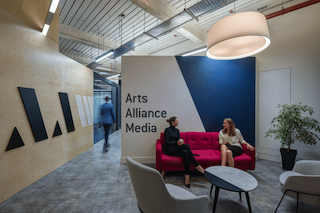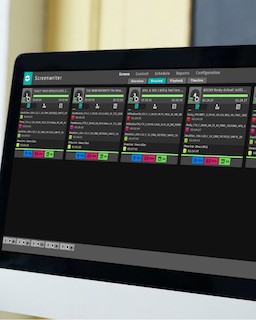 On June 17, digital cinema pioneer Arts Alliance Media will celebrate its 20th anniversary. The company was founded in 2003 by Thomas Hoegh and Arts Alliance Ventures, and initiated the first global digital cinema rollout, replacing 35mm projectors with digital upgrades for the UK’s Digital Screen Network. A short time later, AAM became the founding investor of Lovefilm and Picturehouse Cinemas, which were eventually sold to Amazon and Cineworld respectively. In 2007, AAM negotiated financing agreements with the Hollywood studios and that same year launched its first theatre management system. In 2008 AAM completed the first virtual print fee deal in Europe with the French cinema chain CGR. Another breakthrough came with the launch of the Screenwriter TMS, which replaced the original system, and is celebrating its tenth anniversary this year. In 2017 AAM was wholly acquired by the Chinese cinema technology provider Luxin-Rio and eventually became the official reseller of MediaMotion’s MX4D system and of Shenzhen Timewaying Ltd’s HeyLED cinema screen technology. In 2021 AAM launched the enterprise theatre management system Producer and last year, the company opened an office in the United States to demonstrate its commitment to the global market. I recently spoke, via email, with David Ong, AAM’s chief commercial officer, to get his thoughts about the company’s past, its present, and, especially, its future.
On June 17, digital cinema pioneer Arts Alliance Media will celebrate its 20th anniversary. The company was founded in 2003 by Thomas Hoegh and Arts Alliance Ventures, and initiated the first global digital cinema rollout, replacing 35mm projectors with digital upgrades for the UK’s Digital Screen Network. A short time later, AAM became the founding investor of Lovefilm and Picturehouse Cinemas, which were eventually sold to Amazon and Cineworld respectively. In 2007, AAM negotiated financing agreements with the Hollywood studios and that same year launched its first theatre management system. In 2008 AAM completed the first virtual print fee deal in Europe with the French cinema chain CGR. Another breakthrough came with the launch of the Screenwriter TMS, which replaced the original system, and is celebrating its tenth anniversary this year. In 2017 AAM was wholly acquired by the Chinese cinema technology provider Luxin-Rio and eventually became the official reseller of MediaMotion’s MX4D system and of Shenzhen Timewaying Ltd’s HeyLED cinema screen technology. In 2021 AAM launched the enterprise theatre management system Producer and last year, the company opened an office in the United States to demonstrate its commitment to the global market. I recently spoke, via email, with David Ong, AAM’s chief commercial officer, to get his thoughts about the company’s past, its present, and, especially, its future.
Digital Cinema Report: You joined AAM in 2012, after much of the digital cinema transition had taken place, but before the company introduced Screenwriter. What was your initial role at the company and what are some of your memories from your time there?
 David Ong: I joined AAM in 2012 as the software account manager. AAM was at the tail end of digitalizing cinemas around the world through our virtual print fee program and believed software innovation to be the future once cinemas were digital.
David Ong: I joined AAM in 2012 as the software account manager. AAM was at the tail end of digitalizing cinemas around the world through our virtual print fee program and believed software innovation to be the future once cinemas were digital.
I came from the video game industry and joined AAM at a very exciting time, not to mention AAM was also responsible for content mastering, distribution, and event cinema. The office energy felt like a bazaar with all these departments developing and selling different things. Our customer footprint was rapidly growing at a massive rate, quarter by quarter, which led to a recruitment drive across all departments. Within weeks, I was no longer the newbie, and it was such a joy to welcome new people from outside the industry and help them settle in as I myself was being immersed in this great industry.
DCR: This June 17 marks AAM’s twentieth year in business and is also the tenth anniversary of its flagship product Screenwriter. In your mind, what is the significance of those two milestones?
DG: Alongside longevity, the industry’s support for AAM and our flagship product is something we are very proud of.
 AAM’s company life has mirrored that of any human 20-year-old coming into their own. We have grown, evolved, gained knowledge, experimented, matured and reinvented ourselves through different trends. That life cycle is also reflected in our software and the DNA of our company. Our TMS started out as a mandatory line item in digital cinema and became a mission critical business operational tool. Over the years, every new feature was innovated in parallel to society and business needs, from helping to streamline operational processes to introducing automatic power saving features to reduce energy costs.
AAM’s company life has mirrored that of any human 20-year-old coming into their own. We have grown, evolved, gained knowledge, experimented, matured and reinvented ourselves through different trends. That life cycle is also reflected in our software and the DNA of our company. Our TMS started out as a mandatory line item in digital cinema and became a mission critical business operational tool. Over the years, every new feature was innovated in parallel to society and business needs, from helping to streamline operational processes to introducing automatic power saving features to reduce energy costs.
DCR: How many movie theatres worldwide now have AAM technology?
DG: We are proud to say our software is connected to 43,897 screens worldwide which is one fifth of all cinemas around the world.
Sustainability is a major concern of AAM’s and is part of your message to the industry at CineEurope 2023. How is AAM working to ensure sustainability in its technology and practices?
We use market research data in product development and, according to YOUGOV, adults consistently rank the environment as one of the most important issues facing society today.
Our staff share the same concerns as businesses and, together, are the driving force behind internal discussion and development. Every decision we make, any new steps to innovate, we ask ourselves whether this can also contribute to the wellbeing of the environment.
 This culture and method of thinking has been reflected in a multitude of features that’s present in our software today, from ‘Bookends’ and ‘Auto-Shutdown’ in Screenwriter, to lamp and device management in Lifeguard. It is part of our teams’ personal and company values.
This culture and method of thinking has been reflected in a multitude of features that’s present in our software today, from ‘Bookends’ and ‘Auto-Shutdown’ in Screenwriter, to lamp and device management in Lifeguard. It is part of our teams’ personal and company values.
DCR: What do you see as the next big trends for AAM?
DG: AAM has become a trusted partner for more products and services than ever before. We believe in developing software and hardware solutions for the Total Cinema; becoming a one-stop shop for products and services that run the operational back office and can enhance the movie going experience to drive box office revenues.
With this trust, we are being requested more and more to create an eco-system of solutions that will run cinemas on their behalf through a managed service, enabling cinemas to focus on the front house and providing excellent customer services. It is conceptually a Cinema Operations Managed Service with software operated from our head office and connected to the cinema at its core.
DCR: And what do you envision will be the next big trends for the motion picture industry as a whole?
DG: Internally at AAM, we like to use a sports analogy of watching a game at home versus at a live, filled out stadium which is in reference to home streaming versus going to the cinema. We believe the ever-advancing technology in cinema will keep bringing us back to the cinema and that they will want to create a premium experience for every seat (even if it’s a Standard 2D), not just at PLF screens.
Along with sustainability at the forefront of our minds, we strongly support and believe there will be a focus on Accessible Cinema. Diversity and Inclusion is very important to us we are working with partners to create No Barrier Cinema Experiences for Blind and Deaf people to champion a moral obligation to attract a new, diverse and inclusive audience.
